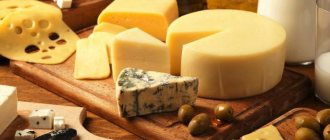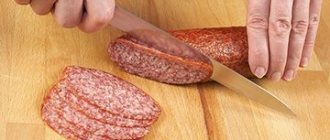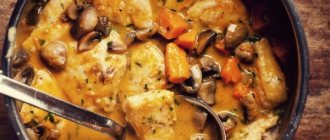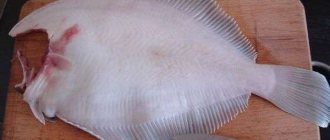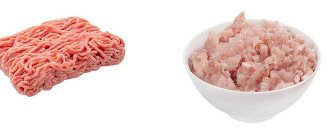Dutch cheese is a fermented milk product made from pasteurized milk fermented with lactic acid bacteria. Under this name, a special variety with original parameters is produced in the post-Soviet space. Consistency - homogeneous; texture - plastic, brittle when folded; eyes - evenly spaced, round or oval, large, but of different sizes; color - from light yellow to “chicken”; The taste of Dutch cheese is sour, creamy, spicy. The crust is thin, ocher, smooth, covered with brown or red paraffin. Most often the heads are tall cylinders, but the shape of bars is also allowed.
How is Dutch cheese made?
To obtain 1.1 kg of the final product, take 10 liters of raw materials - pasteurized milk. In dairy factories, mesophilic lactic acid streptococci are used for fermentation, calcium chloride and salt are used for preservation, and rennet is used for curdling.
Dutch cheese is made like most traditional hard varieties, by heating the milk and then the cheese grains to 32-34°C. During ripening, the temperature regime is changed several times: first the temperature is maintained at 10-12°C, then raised to 14-16°C and again returned to the original regime. Humidity is maintained constant - up to 80%.
A very important step is the control of raw materials. Milk should contain a high amount of protein. For cleaning, separators or filters are used for cleaning. Then the raw material is cooled and allowed to brew to acquire the desired acidity. Pasteurization is carried out at a relatively high temperature - 76°C. This reduces microbiological hazards to a minimum.
How Dutch cheese is prepared in dairy factories
:
- Cool the pasteurized raw material to 32°C, the optimal parameter for activating the lactic acid starter. At the initial stage, calcium chloride is added, which increases the content of the nutrient of the same name, and rennet. Callie formation occurs within 30 minutes.
- Using a “lyra”, the curd is cut into grains measuring 7-8 mm, then the intermediate raw materials are mixed, the pieces are allowed to settle and 1/3 of the whey is drained. Within 30 minutes, increase the temperature to 38-41°C (1°C/1 min.)
- Continue kneading for another 50 minutes until the grain size becomes 4-5 mm. When the acidity increases, cooled whey, removed at the beginning of the process, is poured in.
- To initially separate the whey, the curd mass is placed on a drainage table.
- Then cutting and laying out into shapes is carried out.
- The duration of self-pressing when preparing Dutch cheese is 30 minutes. Then marking is carried out, and the heads are placed under pressure for 4 hours.
- The cheese is salted in 18-20% brine, cooled to 8-10°C, for 5 days. To speed up the process in many factories, part of the salt is introduced when forming a layer on the drainage table.
- Drying is carried out indoors at 18°C. Then the heads are transferred to a chamber, where they are left for 3-4 months at 10-12°C, turning them over 2-3 times daily and monitoring the formation of a crust. The growth of foreign microorganisms is not allowed. Temperature conditions vary depending on the speed of ripening. Maximum exposure is 2.5-3 months.
- After ripening, the heads are washed with 20% brine, dried and coated with paraffin. Then they are delivered to store shelves or placed in refrigerated chambers for storage (8°C), having first been packaged in polymer film.
Making Dutch cheese at home or on small farms differs slightly. In order for the final product to meet the necessary parameters - fat content, taste characteristics, color and texture quality, sour cream is added to the milk (proportions: per 10 l - 300 g). Further, all processes are carried out according to the algorithm described above.
The technology differs at the stage of cutting the clot. The size of the cheese grains is 3x3 cm. Due to their large size, the duration of kneading, according to the recipe for homemade Dutch cheese, increases to 40-50 minutes until the edges of 3x3 mm are reached. Salting begins at the kneading stage. Half the salt is added to the whey. Then the remainder - before self-pressing the heads, after separating the whey from the curd mass. Sufficiently salted intermediate raw materials are placed into the molds.
The weight of the load is increased gradually. For 30 minutes - 1 kg/1 kg of homemade Dutch cheese, after an hour the weight of oppression is tripled, and then - up to 5 kg. Drying is carried out as in industrial conditions, and then the heads are placed in a chamber for aging. After you have prepared Dutch cheese at home, you can taste it within a month, but the taste of such cheese is creamy and salty, without pungency. To obtain a product with a piquant taste and honey-colored cut, the heads should be kept in the chamber for 2-3 months.
- See also how Chanakh cheese is made
Composition and calorie content of Dutch cheese
Pictured is Dutch cheese
To make sure that the cheese contains only natural ingredients, just crumple the cut plate. If it is plastic, then it contains GMOs. The product does not meet the declared parameters and qualities.
Calorie content of Dutch cheese is 233.7-239 kcal per 100 g, of which
:
- Proteins - 26.7 g;
- Fats - 14.1 g;
- Carbohydrates - up to 1 g.
Vitamins per 100 g
:
- Retinol - 0.224 mg;
- Tocopherol - 0.4 mg;
- Ascorbic acid - 0.7 mg;
- Thiamine - 0.03 mg;
- Riboflavin - 0.38 mg;
- Pantothenic acid - 0.3 mg;
- Pyridoxine - 0.11 mg;
- Folic acid - 0.011 mg;
- Cobalamin - 0.00114 mg;
- Nicotinic acid - 6.8 mg.
Macroelements per 100 g
:
- Potassium - 100 mg;
- Calcium - 1000 mg;
- Magnesium - 55 mg;
- Sodium - 1100 mg;
- Phosphorus - 600 mg.
Microelements per 100 g
:
- Iron - 0.7 mg;
- Manganese - 0.1 mg;
- Copper - 0.09 mcg;
- Zinc - 5 mcg.
Predominant amino acids in Dutch cheese
:
- Essential ones are phenylalanine + tyrosine, lysine, leucine, isoleucine and valine. Relatively high amount of tryptophan compared to similar fermented milk products.
- Replaceable ones are aspartic and glutamic acid, serine, proline and tyrosine.
The cholesterol content in products made by different manufacturers ranges from 89 to 101 mg per 100 g. This parameter depends on the protein content and fat content of the raw materials and processing technology.
The fat content of Dutch cheese on a dry matter basis is 45-50%.
If you need to maintain weight or if you want to lose weight, you should choose bar-shaped heads. The energy value of this product is 220 kcal per 100 g, and it also contains much less salt. The shape indicates the dietary version of the variety. The nutrient content is not affected by changes in calorie content.
- See also the composition and calorie content of Rambol cheese
Information for drawing up a technological map (mass fractions)
This data will be required when preparing a Technical and Technological Card for dishes that include Dutch Cheese. To calculate the mass fractions of fat and sugar, it is necessary to know whether the product contains so-called “free” fat and sugar (i.e., determined by laboratory analysis).
| Contains free fat | Yes |
| Contains free sugar | No |
| Contains alcohol | No |
Do you want to develop the right documents for catering? - !
Benefits of Dutch cheese
If during manufacturing the sanitary and hygienic recommendations were strictly followed, the microbiological danger of the product is zero. It can be safely introduced into the diet of children who are just getting acquainted with “adult” food, pregnant women, women during lactation, the elderly and patients recovering from serious operations and illnesses.
Benefits of Dutch cheese
:
- Increases bone strength and strengthens tooth enamel.
- Stimulates the functioning of the salivary glands, which reduces the incidence of periodontal disease, periodontitis and stomatitis.
- Increases the production of digestive enzymes, improves the absorption of proteins and carbohydrates.
- Normalizes blood glucose levels.
- Stabilizes metabolic processes at the cellular level, maintains water-electrolyte and acid-base balance, retains moisture in the body. This prevents loss of skin tone and stops aging.
- Maintains oxygen balance, improves the functioning of the cardiovascular system.
- Increases tone and restores energy reserve.
The recommended daily serving of Dutch cheese is 60-80 g. It can be eaten in the morning or throughout the day. If it is necessary to adhere to a low-calorie diet, the “dose” is reduced by 1.5 times and extended throughout the day. If you eat a thin translucent piece before bed, a fat layer will not form. On the contrary, falling asleep will speed up, and the night's rest will be complete. A snack with this variety prevents the development of depression when it is necessary to lose weight, and diet failure does not occur.
- Read more about the benefits of Chechil cheese
Leiden cheese with cumin
This cheese has a lower fat percentage than Gouda, typically ranging from 20 to 40 percent. Due to its low fat content, dryness and saltiness, this cheese was well suited for long sea voyages in the 17th century, as it could be easily stored for a long time.
The original cumin cheese from Leiden is crumbly and piquant. It is aged for at least 6 months. Further aging will only enhance the flavor of the cumin and give the cheese a more tart flavor.
Contraindications and harm of Dutch cheese
If you are intolerant to milk protein, you will have to refuse this valuable food product. Allergic reactions may occur if palm oil or GMO products were used in production. Therefore, you should study what is written on the label.
Dutch cheese can cause harm if you overeat. For chronic diseases - gastritis, a history of ulcers, pancreatitis - the recommended dosage should be halved. Sourness and pungency irritate taste buds, increasing the secretion of digestive enzymes, hydrochloric and bile acid. Due to aggressive effects, erosive and ulcerative defects occur on the mucous membrane of the esophagus and stomach.
It is worth temporarily limiting the consumption of Dutch cheese in case of inflammatory processes of the urinary system due to its high salt content. In case of liver diseases, a short-term deterioration of the condition is possible due to the increased calorie content of the product: the body may not be able to cope with processing and absorption, nausea, dizziness and diarrhea will occur.
This variety contains a high amount of the essential amino acid tryptophan. If abused, it may increase the frequency of migraine attacks and cause anxiety.
Benefits and harms
Eating Dutch cheese has a beneficial effect on human health: blood sugar levels are normalized, the skeletal system is strengthened, and the condition of muscle tissue, hair and nails is improved. This beneficial effect on health occurs due to the beneficial substances included in the product: phosphorus, iron, sodium, calcium, vitamins of various groups.
Due to its high energy value, the product is able to satisfy hunger and restore wasted energy in a short time, so even one cheese sandwich is enough for a full meal.
However, cheese may be harmful to some people. If you have problems with the liver and gall bladder, it is not recommended to eat cheeses, as they put a lot of strain on the above-mentioned internal organs.
Obese people are also at risk, because the product promotes the accumulation of fatty deposits in the body. When following a diet for weight loss, Dutch cheese is still included in the diet, provided it is consumed in small portions to satisfy hunger during fasting weeks. With an unhealthy digestive system, lactic acid, which is part of the product, can aggravate the condition, being an irritant.
Recipes with Dutch cheese
This variety is served as an appetizer and dessert, and is used for preparing meat, fish or vegetable dishes, various salads and baked goods. The product melts well, and the taste goes well with almost all culinary ingredients.
Recipes with Dutch cheese:
- Delicate salad
. Boiled chicken fillet, separated into fibers, is poured into the bottom of the salad bowl and sprinkled with crushed roasted almonds. Next, grated cheese and large white seedless grapes, cut in half. Lubricate with mayonnaise. Next is a layer of fillet, almonds, mayonnaise and cheese. The top is decorated with grapes. - Fish soufflé
. Pollock fillet or pieces of hake are stewed with carrots, onions and spices, so that the liquid barely covers the surface, for 20 minutes. It is better to use a cast iron with a tight lid or a slow cooker. The finished fish is disassembled, the bones are removed and ground with butter and grated Dutch cheese. Serve both warm and chilled. - Muffin
. Preheat the oven to 170°C. Knead the cheese dough: 2 cups flour, 1 cup each grated cheese and boiled warm milk, 3 tbsp. l. grated poppy seeds and 0.5 tsp. salt and baking soda. Cake molds are greased from the inside with butter and filled with dough. Bake for 15-20 minutes. To get a more golden brown crust, brush the surface of the future muffin with beaten egg. - Cauliflower Casserole
. Heat the oven to 170-180°C. Cauliflower is disassembled into inflorescences, dipped in boiling water, 50 g of apple cider vinegar and saffron are added on the tip of a knife. Place in a colander and allow the liquid to drain. Then cut into equal pieces. While the cabbage is cooking, place 2 tomatoes in boiling water for 1 minute, remove the skin and cut into large slices. To make the filling, beat 3 eggs with a glass of milk. Place cabbage, tomatoes, spices and herbs to taste on a greased baking sheet. Pour over and sprinkle with grated cheese so that it forms a layer. Bake for 10-15 minutes. What’s good about this casserole is that it doesn’t have the unpleasant smell of boiled cabbage.
See also recipes for dishes with Tulum cheese.
